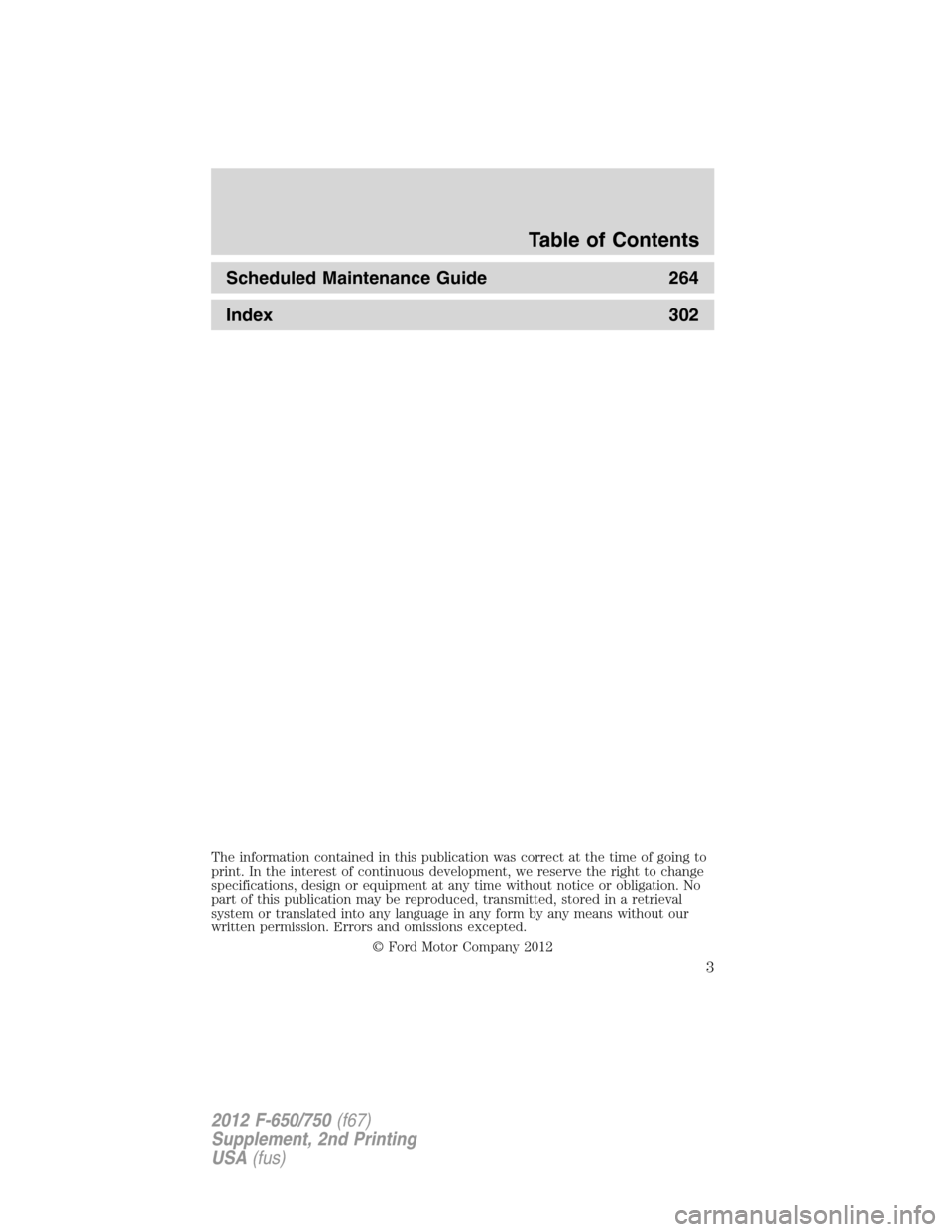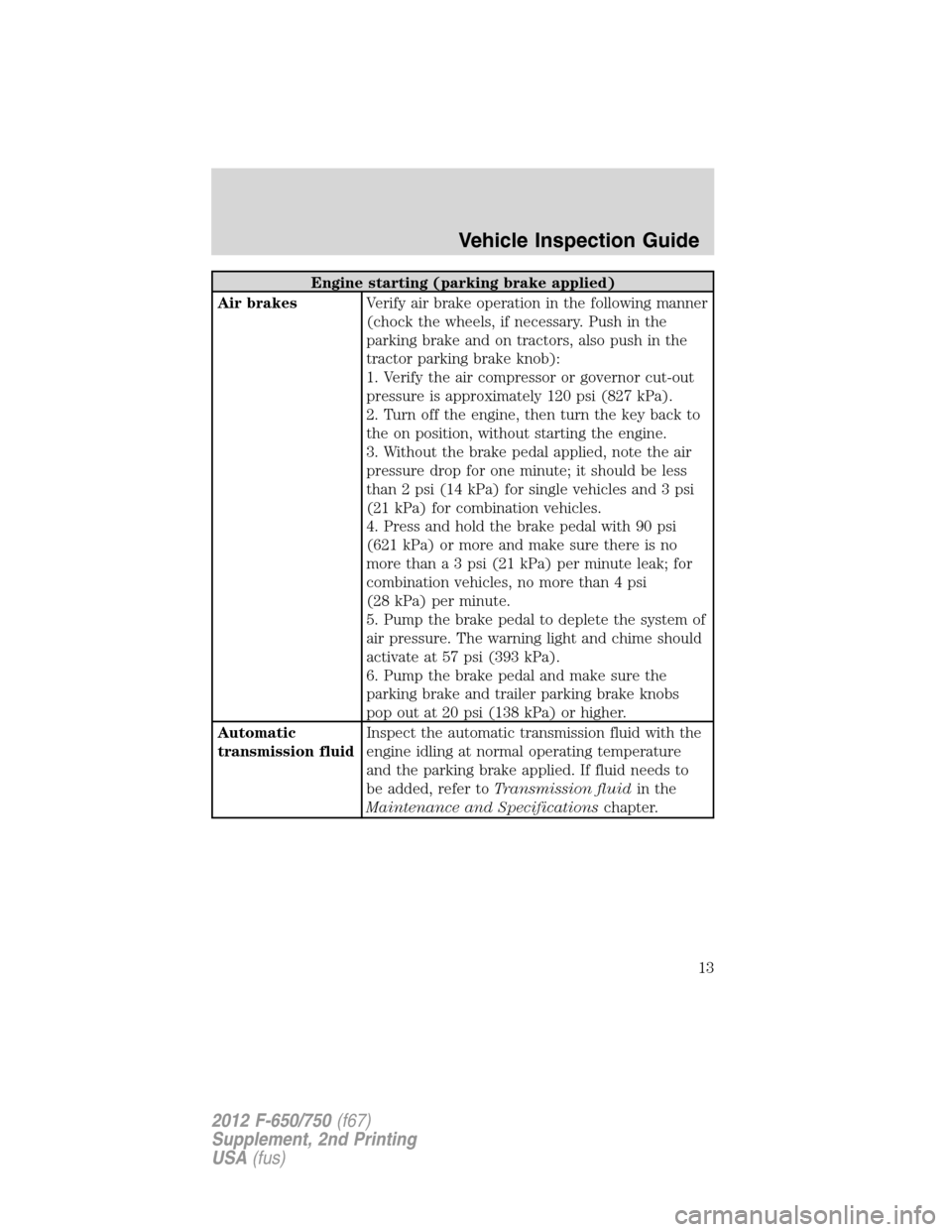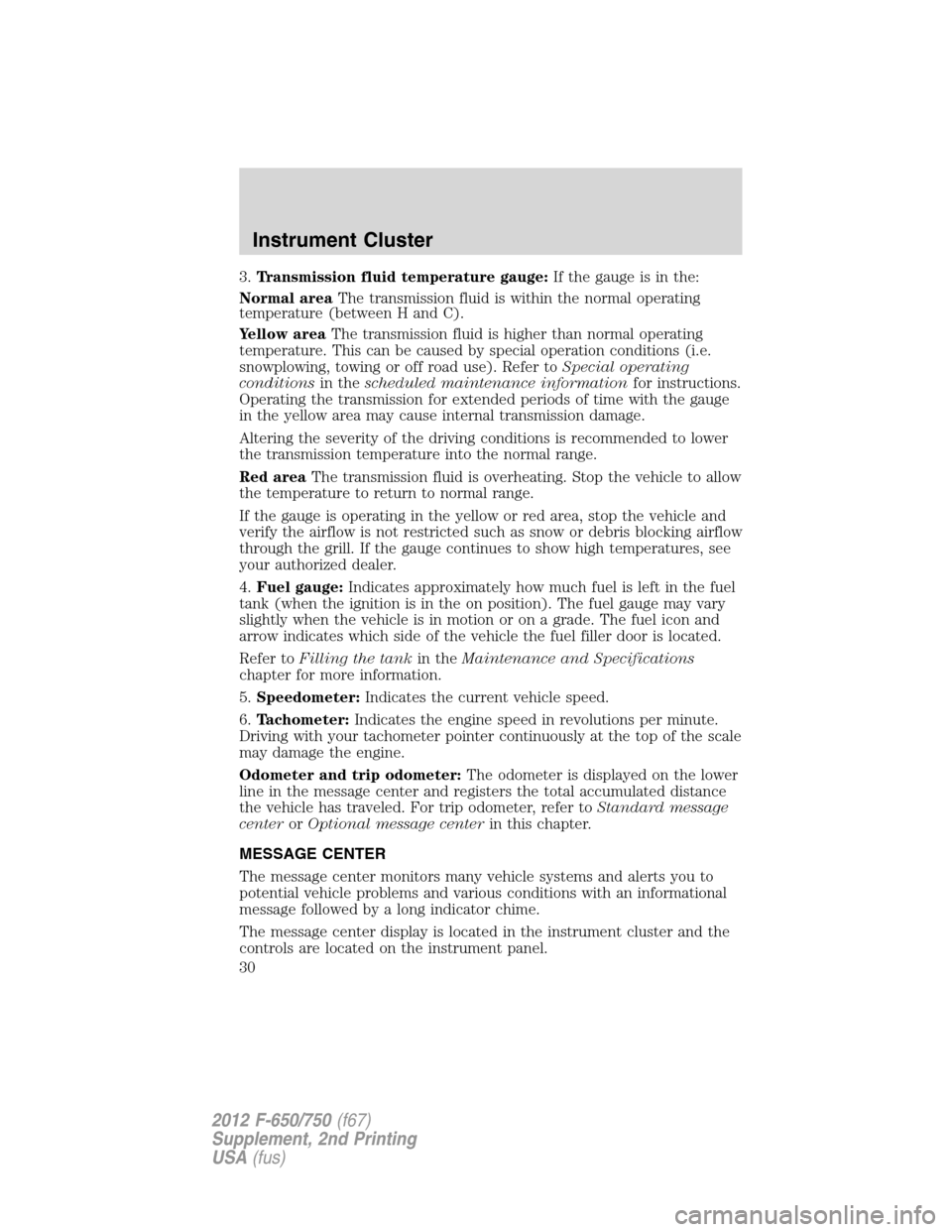2012 FORD F650 maintenance
[x] Cancel search: maintenancePage 2 of 306

Seating and Safety Restraints 69
Seating 69
Rear seats 78
Safety restraints 80
Child restraints 89
Driving 103
Starting 103
Brakes 110
Air suspension 129
Transmission operation 132
Vehicle loading 146
Roadside Emergencies 152
Hazard flasher switch 153
Fuses and relays 153
Jump starting 162
Wrecker towing 166
Customer Assistance 170
Getting assistance outside the U.S. and Canada 172
Reporting safety defects (U.S. only) 174
Reporting safety defects (Canada only) 174
Cleaning 175
Underbody preservation 179
Maintenance and Specifications 181
Hood 189
Engine oil 192
Battery 195
Engine coolant 197
Fuel information 204
Diesel Exhaust Fluid (DEF) 210
Wheel lug nut torque 237
Tire information 238
Lubricant specifications 245
Refill capacities 259
Engine data 262
Table of Contents
2
2012 F-650/750(f67)
Supplement, 2nd Printing
USA(fus)
Page 3 of 306

Scheduled Maintenance Guide 264
Index 302
The information contained in this publication was correct at the time of going to
print. In the interest of continuous development, we reserve the right to change
specifications, design or equipment at any time without notice or obligation. No
part of this publication may be reproduced, transmitted, stored in a retrieval
system or translated into any language in any form by any means without our
written permission. Errors and omissions excepted.
© Ford Motor Company 2012
Table of Contents
3
2012 F-650/750(f67)
Supplement, 2nd Printing
USA(fus)
Page 10 of 306

To be sure your vehicle is ready to operate, conduct a pre-trip inspection
at the beginning of each work period. Follow the steps listed in this
section to ensure a proper vehicle inspection procedure. The pages in
this section may be produced locally and used on a regular basis.
VEHICLE INSPECTION INFORMATION
Note:Always make sure the parking brake is applied before starting the
engine.
Engine compartment (with engine stopped)
Engine oilUse the dipstick to verify the oil level is in the
proper operating range.
Engine coolantLook through the plastic reservoir or the clear
sight glass on the reservoir (depending upon
vehicle equipment) and verify the coolant level is
within the proper operating range as marked on
the reservoir.Do not remove pressure cap
until the coolant has cooled.
Power steering
fluidVerify that the fluid level is in the proper
operating range. Refer toPower steering fluidin
theMaintenance and Specificationschapter.
Brake fluidRemove the master cylinder caps and inspect the
fluid level. The full mark is at the bottom of the
opening of the fluid ports.
Hydraulic clutch
fluidRemove the cap and inspect the fluid level. The
full mark is at the step of the reservoir.
Belts (fan,
alternator, water
pump and A/C
compressor)Inspect for glazing, fraying or cracking. There
should be no more than 5-7 cracks per rib, per
inch (2.5 cm).
Fluid leaksInspect for signs of fluid puddles, dripping fluid
on the ground under the engine or the underside
of the engine.
HVAC air inletInspect for debris that may have collected on the
HVAC air inlet grille or inside the exterior module
as this may cause reduced system performance.
Vehicle Inspection Guide
10
2012 F-650/750(f67)
Supplement, 2nd Printing
USA(fus)
Page 13 of 306

Engine starting (parking brake applied)
Air brakesVerify air brake operation in the following manner
(chock the wheels, if necessary. Push in the
parking brake and on tractors, also push in the
tractor parking brake knob):
1. Verify the air compressor or governor cut-out
pressure is approximately 120 psi (827 kPa).
2. Turn off the engine, then turn the key back to
the on position, without starting the engine.
3. Without the brake pedal applied, note the air
pressure drop for one minute; it should be less
than 2 psi (14 kPa) for single vehicles and 3 psi
(21 kPa) for combination vehicles.
4. Press and hold the brake pedal with 90 psi
(621 kPa) or more and make sure there is no
more than a 3 psi (21 kPa) per minute leak; for
combination vehicles, no more than 4 psi
(28 kPa) per minute.
5. Pump the brake pedal to deplete the system of
air pressure. The warning light and chime should
activate at 57 psi (393 kPa).
6. Pump the brake pedal and make sure the
parking brake and trailer parking brake knobs
pop out at 20 psi (138 kPa) or higher.
Automatic
transmission fluidInspect the automatic transmission fluid with the
engine idling at normal operating temperature
and the parking brake applied. If fluid needs to
be added, refer toTransmission fluidin the
Maintenance and Specificationschapter.
Vehicle Inspection Guide
13
2012 F-650/750(f67)
Supplement, 2nd Printing
USA(fus)
Page 23 of 306

Diesel particulate filter (diesel
engine only):Illuminates when the
soot level in the DPF has reached a
point where it requires operator
assistance. Refer toDiesel
particulate filterin the
Maintenance and Specifications
chapter and your engine operator’s
manual, for more details.
Do not shift (Allison automatic
transmission only):Illuminates
while driving if a problem has been
detected and shifting may be
restricted. Depending upon the
severity of the problem, the
read-out digit on the shifter display
may be blank. Operation may
continue in order to reach service assistance. The ECU may not respond
to shift selector requests, since operating limitations are being placed on
the transmission, i.e. upshifts and downshifts may be restricted.
Direction changes do not occur.
Refer to your transmission operator’s manual for more information.
Electronic locking differential
(if equipped):Displays when using
the electronic locking differential.
Engine oil pressure (gasoline
engine only):Illuminates when
engine oil pressure is low.
High beams:Illuminates when the
high-beam headlamps are turned on.
Instrument Cluster
23
2012 F-650/750(f67)
Supplement, 2nd Printing
USA(fus)
Page 25 of 306

Service engine soon:Illuminates
when the ignition is first turned to
the on position to check the bulb
and to indicate whether the vehicle
is ready for Inspection/Maintenance
(I/M) testing.
Solid illumination after the engine is
started indicates the on-board
diagnostics system (OBD-II) has detected a malfunction.
WARNING:Under engine misfire conditions, excessive exhaust
temperatures could damage the catalytic converter, the fuel
system, interior floor coverings or other vehicle components, possibly
causing a fire.
Speed control (if equipped):
Illuminates when the speed control
system is engaged. Turns off when
the speed control system is
disengaged.
Stop engine (diesel engine only):
This red lamp illuminates when the
engine needs to be stopped (as soon
as it can be safely done). If the lamp
begins flashing, automatic engine shutdown may take place in as little as
20 seconds.
WARNING:In the event of engine shutdown, make sure the
vehicle is safely off the road and the problem is remedied prior
to returning to the road. Failure to remove the vehicle from the road
could result in an accident, causing serious injury or death.
If the engine shuts down, it can be restarted and operated for
30 seconds at a time or until the problem is corrected. For more
information, refer toEngine automatic shutdown warning light or
chimein theDrivingchapter of this owner guide and/or your engine
operator’s manual.
Refer to your engine operator’s manual for specific information regarding
this feature. Drivers of electronically-controlled engines should know the
extent of warning engine shutdown system before operating the vehicle.
Instrument Cluster
25
2012 F-650/750(f67)
Supplement, 2nd Printing
USA(fus)
Page 29 of 306

5.Fuel gauge:Indicates approximately how much fuel is left in the fuel
tank (when the ignition is in the on position). The fuel gauge reading
may vary slightly when the vehicle is in motion or on a grade. Refer to
Filling the tankin theMaintenance and Specificationschapter for
more information.
6.Speedometer:Indicates the current vehicle speed.
Odometer and trip odometer:The odometer is displayed on the lower
line in the message center and registers the total accumulated distance
the vehicle has traveled. For trip odometer information, refer toMessage
centerin this chapter.
Base instrument cluster for gasoline engine with standard
measure shown; metric similar
1.Engine oil pressure gauge:Indicates engine oil pressure. The
needle should stay in the normal operating range (between L and H). If
the needle falls below the normal range, stop the vehicle, turn off the
engine and check the engine oil level. Add oil if needed. If the oil level is
correct, have your vehicle checked at your authorized dealer.
2.Engine coolant temperature gauge:Indicates engine coolant
temperature. At normal operating temperature, the needle will be in the
normal range (between H and C).If it enters the red section, the
engine is overheating. Stop the vehicle as soon as safely possible,
switch off the engine and let the engine cool.
WARNING:Never remove the coolant reservoir cap while the
engine is running or hot.
1234
56
Instrument Cluster
29
2012 F-650/750(f67)
Supplement, 2nd Printing
USA(fus)
Page 30 of 306

3.Transmission fluid temperature gauge:If the gauge is in the:
Normal areaThe transmission fluid is within the normal operating
temperature (between H and C).
Yellow areaThe transmission fluid is higher than normal operating
temperature. This can be caused by special operation conditions (i.e.
snowplowing, towing or off road use). Refer toSpecial operating
conditionsin thescheduled maintenance informationfor instructions.
Operating the transmission for extended periods of time with the gauge
in the yellow area may cause internal transmission damage.
Altering the severity of the driving conditions is recommended to lower
the transmission temperature into the normal range.
Red areaThe transmission fluid is overheating. Stop the vehicle to allow
the temperature to return to normal range.
If the gauge is operating in the yellow or red area, stop the vehicle and
verify the airflow is not restricted such as snow or debris blocking airflow
through the grill. If the gauge continues to show high temperatures, see
your authorized dealer.
4.Fuel gauge:Indicates approximately how much fuel is left in the fuel
tank (when the ignition is in the on position). The fuel gauge may vary
slightly when the vehicle is in motion or on a grade. The fuel icon and
arrow indicates which side of the vehicle the fuel filler door is located.
Refer toFilling the tankin theMaintenance and Specifications
chapter for more information.
5.Speedometer:Indicates the current vehicle speed.
6.Tachometer:Indicates the engine speed in revolutions per minute.
Driving with your tachometer pointer continuously at the top of the scale
may damage the engine.
Odometer and trip odometer:The odometer is displayed on the lower
line in the message center and registers the total accumulated distance
the vehicle has traveled. For trip odometer, refer toStandard message
centerorOptional message centerin this chapter.
MESSAGE CENTER
The message center monitors many vehicle systems and alerts you to
potential vehicle problems and various conditions with an informational
message followed by a long indicator chime.
The message center display is located in the instrument cluster and the
controls are located on the instrument panel.
Instrument Cluster
30
2012 F-650/750(f67)
Supplement, 2nd Printing
USA(fus)